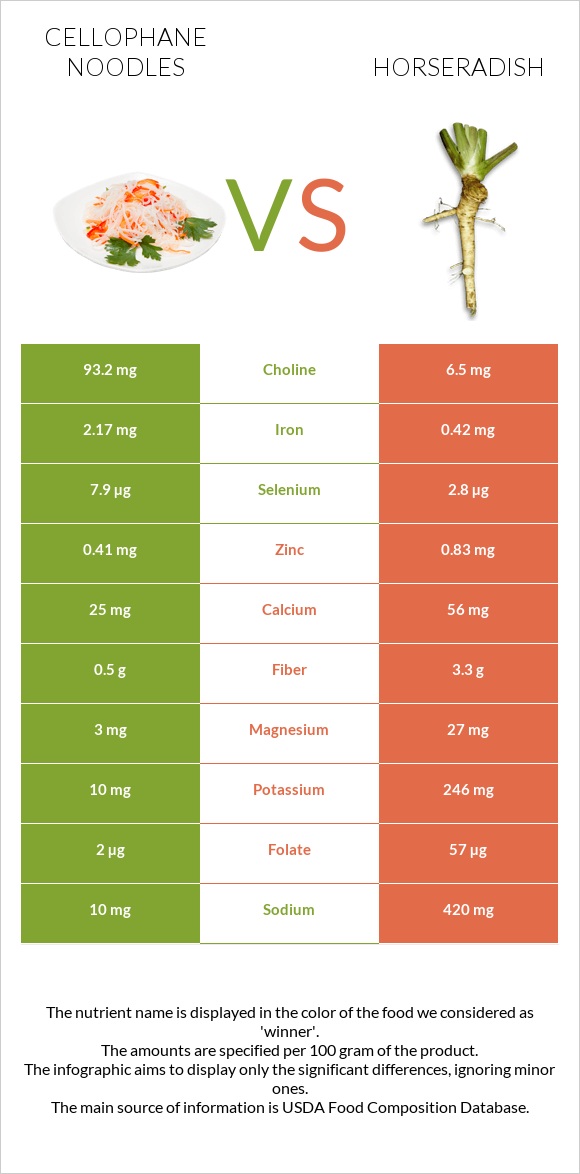Cellophane noodles vs. Horseradish — In-Depth Nutrition Comparison
Compare
What are the differences between cellophane noodles and horseradish?
- Cellophane noodles are higher in iron, choline, vitamin B1, and selenium, yet horseradish is higher in vitamin C, folate, fiber, potassium, and magnesium.
- Horseradish's daily need coverage for vitamin C is 28% more.
- Cellophane noodles have 19 times more vitamin B1 than horseradish. While cellophane noodles have 0.15mg of vitamin B1, horseradish has only 0.008mg.
- The amount of sodium in cellophane noodles is lower.
We used Noodles, chinese, cellophane or long rice (mung beans), dehydrated and Horseradish, prepared types in this article.
Infographic

Infographic link
Mineral Comparison
Mineral comparison score is based on the number of minerals by which one or the other food is richer. The "coverage" charts below show how much of the daily needs can be covered by 300 grams of the food.
| Contains more IronIron | +416.7% |
| Contains more CopperCopper | +39.7% |
| Contains less SodiumSodium | -97.6% |
| Contains more SeleniumSelenium | +182.1% |
| Contains more MagnesiumMagnesium | +800% |
| Contains more CalciumCalcium | +124% |
| Contains more PotassiumPotassium | +2360% |
| Contains more ZincZinc | +102.4% |
| Contains more ManganeseManganese | +26% |
Vitamin Comparison
Vitamin comparison score is based on the number of vitamins by which one or the other food is richer. The "coverage" charts below show how much of the daily needs can be covered by 300 grams of the food.
| Contains more Vitamin EVitamin E | +1200% |
| Contains more Vitamin B1Vitamin B1 | +1775% |
| Contains more Vitamin CVitamin C | +∞% |
| Contains more Vitamin B2Vitamin B2 | +∞% |
| Contains more Vitamin B3Vitamin B3 | +93% |
| Contains more Vitamin B6Vitamin B6 | +46% |
| Contains more Vitamin KVitamin K | +∞% |
| Contains more FolateFolate | +2750% |
All nutrients comparison - raw data values
| Nutrient |  |
 |
DV% diff. |
| Vitamin C | 0mg | 24.9mg | 28% |
| Carbs | 86.09g | 11.29g | 25% |
| Iron | 2.17mg | 0.42mg | 22% |
| Sodium | 10mg | 420mg | 18% |
| Choline | 93.2mg | 6.5mg | 16% |
| Calories | 351kcal | 48kcal | 15% |
| Folate | 2µg | 57µg | 14% |
| Vitamin B1 | 0.15mg | 0.008mg | 12% |
| Fiber | 0.5g | 3.3g | 11% |
| Selenium | 7.9µg | 2.8µg | 9% |
| Potassium | 10mg | 246mg | 7% |
| Magnesium | 3mg | 27mg | 6% |
| Zinc | 0.41mg | 0.83mg | 4% |
| Calcium | 25mg | 56mg | 3% |
| Copper | 0.081mg | 0.058mg | 3% |
| Protein | 0.16g | 1.18g | 2% |
| Vitamin B2 | 0mg | 0.024mg | 2% |
| Vitamin B6 | 0.05mg | 0.073mg | 2% |
| Polyunsaturated fat | 0.018g | 0.339g | 2% |
| Fats | 0.06g | 0.69g | 1% |
| Vitamin E | 0.13mg | 0.01mg | 1% |
| Manganese | 0.1mg | 0.126mg | 1% |
| Vitamin B3 | 0.2mg | 0.386mg | 1% |
| Vitamin K | 0µg | 1.3µg | 1% |
| Net carbs | 85.59g | 7.99g | N/A |
| Sugar | 0g | 7.99g | N/A |
| Phosphorus | 32mg | 31mg | 0% |
| Vitamin B5 | 0.1mg | 0.093mg | 0% |
| Saturated fat | 0.017g | 0.09g | 0% |
| Monounsaturated fat | 0.008g | 0.13g | 0% |
| Tryptophan | 0.002mg | 0% | |
| Threonine | 0.005mg | 0% | |
| Isoleucine | 0.007mg | 0% | |
| Leucine | 0.013mg | 0% | |
| Lysine | 0.011mg | 0% | |
| Methionine | 0.002mg | 0% | |
| Phenylalanine | 0.01mg | 0% | |
| Valine | 0.008mg | 0% | |
| Histidine | 0.005mg | 0% |
Macronutrient Comparison
Macronutrient breakdown side-by-side comparison
Protein:
0.16 g
Fats:
0.06 g
Carbs:
86.09 g
Water:
13.42 g
Other:
0.27 g
Protein:
1.18 g
Fats:
0.69 g
Carbs:
11.29 g
Water:
85.08 g
Other:
1.76 g
| Contains more CarbsCarbs | +662.5% |
| Contains more ProteinProtein | +637.5% |
| Contains more FatsFats | +1050% |
| Contains more WaterWater | +534% |
| Contains more OtherOther | +551.9% |
Fat Type Comparison
Fat type breakdown side-by-side comparison
Saturated fat:
Sat. Fat
0.017 g
Monounsaturated fat:
Mono. Fat
0.008 g
Polyunsaturated fat:
Poly. Fat
0.018 g
Saturated fat:
Sat. Fat
0.09 g
Monounsaturated fat:
Mono. Fat
0.13 g
Polyunsaturated fat:
Poly. Fat
0.339 g
| Contains less Sat. FatSaturated fat | -81.1% |
| Contains more Mono. FatMonounsaturated fat | +1525% |
| Contains more Poly. FatPolyunsaturated fat | +1783.3% |





